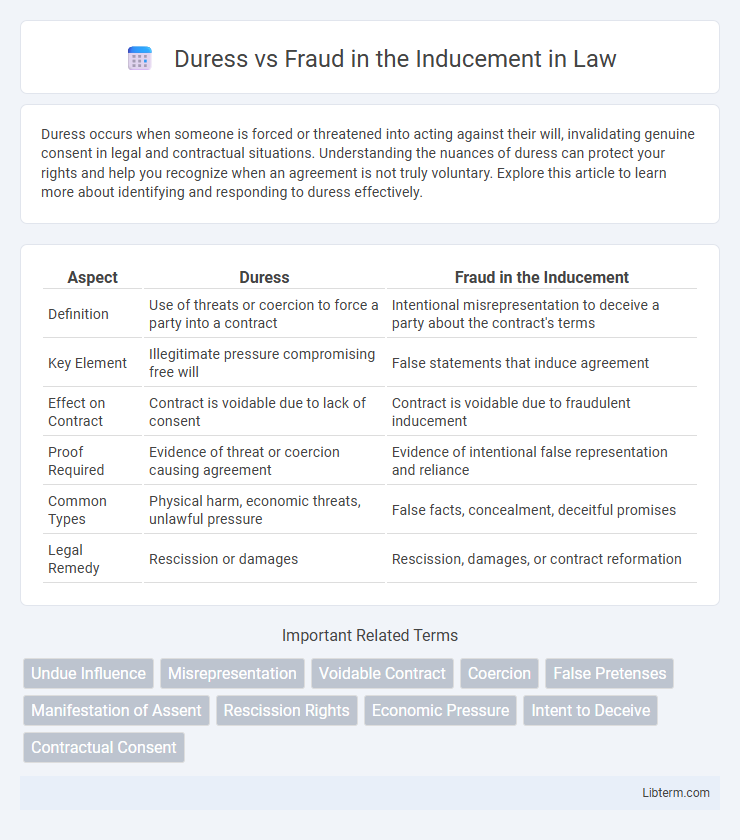Duress occurs when someone is forced or threatened into acting against their will, invalidating genuine consent in legal and contractual situations. Understanding the nuances of duress can protect your rights and help you recognize when an agreement is not truly voluntary. Explore this article to learn more about identifying and responding to duress effectively.
Table of Comparison
| Aspect | Duress | Fraud in the Inducement |
|---|---|---|
| Definition | Use of threats or coercion to force a party into a contract | Intentional misrepresentation to deceive a party about the contract's terms |
| Key Element | Illegitimate pressure compromising free will | False statements that induce agreement |
| Effect on Contract | Contract is voidable due to lack of consent | Contract is voidable due to fraudulent inducement |
| Proof Required | Evidence of threat or coercion causing agreement | Evidence of intentional false representation and reliance |
| Common Types | Physical harm, economic threats, unlawful pressure | False facts, concealment, deceitful promises |
| Legal Remedy | Rescission or damages | Rescission, damages, or contract reformation |
Understanding Duress: A Legal Overview
Duress in contract law refers to a situation where one party is forced into an agreement through threats or undue pressure, rendering the contract voidable. Unlike fraud in the inducement, which involves intentional misrepresentation to deceive, duress concerns coercion that compromises free will. Courts assess the presence of duress by examining whether the victim had a reasonable alternative and the nature of the threat, emphasizing the importance of voluntary consent for contract validity.
Defining Fraud in the Inducement
Fraud in the inducement occurs when one party is intentionally misled about the nature or terms of a contract, causing them to enter into an agreement they otherwise would not have. It involves deliberate deception regarding material facts, which induces the victim to consent based on false information. This type of fraud renders the contract voidable because the victim's consent was not genuinely informed or voluntary.
Key Differences Between Duress and Fraud
Duress involves coercion or threats that force a party into an agreement, making the contract voidable due to lack of free will, whereas fraud entails intentional misrepresentation or deceit to induce agreement, rendering the contract voidable for lack of informed consent. The key difference lies in the nature of pressure: duress uses wrongful threats to compel action, while fraud manipulates facts to mislead the other party. Courts typically require proof of actual threat for duress and factual falsehood for fraud, impacting remedies and contract enforceability.
Elements Required to Prove Duress
To prove duress in contract law, a plaintiff must demonstrate a wrongful threat or coercion by the defendant that overcomes the plaintiff's free will, causing the contract to be executed under pressure. Essential elements include proof of a threat of harm or unlawful act, the absence of reasonable alternatives for the plaintiff, and that the threat was a significant factor inducing the agreement. Unlike fraud in the inducement, duress involves compulsion rather than deception to invalidate consent.
Elements Required to Prove Fraud in the Inducement
Proving fraud in the inducement requires demonstrating a false representation of a material fact made knowingly or with reckless disregard for its truth, intended to deceive the other party. The claimant must show justifiable reliance on this misrepresentation and resulting damages caused by entering into the contract based on the false information. Establishing intent to induce assent differentiates fraud in the inducement from duress, where coercion rather than deception invalidates consent.
Legal Consequences of Duress in Contracts
Duress in contract law invalidates the agreement when one party is forced into consent through threats, physical harm, or unlawful pressure, rendering the contract voidable. Courts typically require proof that the victim had no reasonable alternative but to agree under duress, which leads to rescission or reformation of the contract. Unlike fraud in the inducement, which misrepresents facts to deceive, duress undermines free will, emphasizing the contract's lack of genuine consent and resulting in legal remedies to protect the coerced party.
Legal Consequences of Fraud in the Inducement
Fraud in the inducement invalidates a contract because it involves intentional misrepresentation that deceives a party into agreement, leading to legal consequences such as rescission, damages, and possible punitive penalties. Courts may void the contract to restore parties to their original positions, reflecting a fundamental breach of consent caused by fraudulent conduct. Unlike duress, which coerces through threats or force, fraud in the inducement undermines contract validity by corrupting the fundamental truth relied upon during agreement formation.
Common Examples: Duress vs Fraud Scenarios
Duress scenarios often involve threats of physical harm or unlawful confinement to force an individual into a contract, such as a person signing an agreement under the threat of violence. Fraud in the inducement typically includes deceptive misrepresentations or false statements, like a seller knowingly providing false information about a product's quality to persuade a buyer. Both cases invalidate consent, but duress hinges on coercion while fraud centers on intentional deception.
Remedies Available for Duress and Fraud Victims
Victims of duress in contract law can seek remedies such as contract rescission or reformation due to improper coercion undermining valid consent. Fraud in the inducement allows victims to pursue rescission, damages for pecuniary loss, and sometimes punitive damages for intentional misrepresentation. Courts frequently emphasize restitution to restore parties to their original positions and may enforce equitable remedies depending on the severity of duress or fraudulent conduct.
Preventing Duress and Fraud in Legal Agreements
Preventing duress and fraud in legal agreements requires clear evidence of voluntary consent and transparent communication between parties. Implementing thorough documentation, verifying identities, and conducting due diligence reduce the risk of coercion or misrepresentation during contract formation. Courts often assess the presence of duress or fraud by examining the circumstances surrounding the agreement, emphasizing the necessity of fair negotiation practices and honest disclosure.
Duress Infographic

 libterm.com
libterm.com